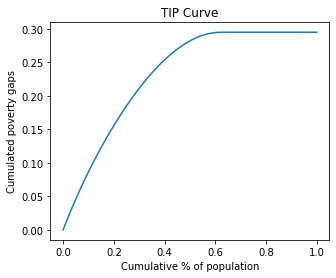Apode Tutorial¶
This tutorial shows the current functionalities of the Apode package. Apode contains various methods to calculate measures and generate graphs on the following topics:
Poverty
Inequality
Welfare
Polarization
Concentration
Getting Started¶
ApodeData class¶
The objects are created as:
ad = ApodeData(DataFrame,income_column)
Where income_column is the name of the column of interest for the analysis in the dataframe.
Methods that calculate indicators:
ad.poverty(method,*args)
ad.ineq(method,*args)
ad.welfare(method,*args)
ad.polarization(method,*args)
ad.concentration(method,*args)
Métodos that generate graphs:
ad.plot.hist()
ad.plot.tip(**kwargs)
ad.plot.lorenz(**kwargs)
ad.plot.pen(**kwargs)
For an introduction to the Python language see Beginner Guide.
Data Creation and Description¶
Data can be generated manually or by means of a simulation. They are contained in a DataFrame object.
Other categoric variables that allow for the indicators to be applied by groups (groupby) might be available.
[1]:
import numpy as np
import pandas as pd
from apode import ApodeData
from apode import datasets
Manual data loading¶
An object can be generated from a DataFrame or from a valid argument in the DataFrame method.
[2]:
x = [23, 10, 12, 21, 4, 8, 19, 15, 11, 9]
df1 = pd.DataFrame({'x':x})
ad1 = ApodeData(df1, income_column="x")
ad1
[2]:
| x | |
|---|---|
| 0 | 23 |
| 1 | 10 |
| 2 | 12 |
| 3 | 21 |
| 4 | 4 |
| 5 | 8 |
| 6 | 19 |
| 7 | 15 |
| 8 | 11 |
| 9 | 9 |
Data simulation¶
The module datasets contains some distribution examples commonly used to model the income distribution. For example:
[3]:
# Generate data
n = 1000 # observations
seed = 12345
ad2 = datasets.make_weibull(seed=seed,size=n)
ad2.describe()
[3]:
| x | |
|---|---|
| count | 1000.000000 |
| mean | 45.408376 |
| std | 30.207372 |
| min | 0.112876 |
| 25% | 22.363891 |
| 50% | 39.404779 |
| 75% | 62.690946 |
| max | 190.596705 |
[4]:
# Plotting the distribution
ad2.plot();
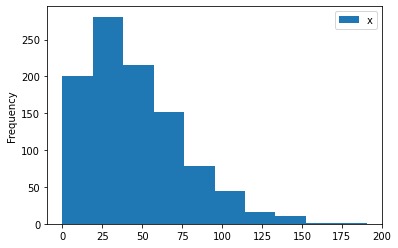
Other distributions are: uniform, lognormal, exponential, pareto, chisquare and gamma. For help type:
[5]:
help(datasets.make_weibull)
Help on function make_weibull in module apode.datasets:
make_weibull(seed=None, size=100, a=1.5, c=50, nbin=None)
Weibull Distribution.
Parameters
----------
seed: int, optional(default=None)
size: int, optional(default=100)
a: float, optional(default=1.5)
c: float, optional(default=50)
nbin: int, optional(default=None)
Return
------
out: float array
Array of random numbers.
Poverty¶
The following poverty measures are implemented:
headcount: Headcount Indexgap: Poverty gap Indexseverity: Poverty Severity Indexfgt: Foster–Greer–Thorbecke Indicessen: Sen Indexsst: Sen-Shorrocks-Thon Indexwatts: Watts Indexcuh: Clark, Ulph and Hemming Indicestakayama: Takayama Indexkakwani: Kakwani Indicesthon: Thon Indexbd: Blackorby and Donaldson Indiceshagenaars: Hagenaars Indexchakravarty: Chakravarty Indices
Also the TIP curve, which allows for a graphic comparison of poverty amongst different distributions.
Numerical measures¶
All the methods require the poverty line (pline) as argument for get a absolute measure of poverty.
[6]:
pline = 50 # Poverty line
p = ad2.poverty('headcount',pline=pline)
p
[6]:
0.626
If the argument is omitted 0.5*median is used. Other options for a relative measure of poverty are:
[7]:
# pline = factor*stat [stat: mean, median, quantile_q]
p1 = ad2.poverty('headcount') # pline= 0.5*median(y)
p2 = ad2.poverty('headcount', pline='median', factor=0.5)
p3 = ad2.poverty('headcount', pline='quantile', q=0.5, factor=0.5)
p4 = ad2.poverty('headcount', pline='mean', factor=0.5)
p1, p2, p3, p4
[7]:
(0.214, 0.214, 0.214, 0.256)
Some methods require an additional parameter, alpha. In some cases, a default value is set for it. The summary function shows the result of various methods:
[17]:
df_p = poverty_summary(ad2)
df_p
[17]:
| method | measure | |
|---|---|---|
| 0 | headcount | 0.214000 |
| 1 | gap | 0.088038 |
| 2 | severity | 0.052488 |
| 3 | fgt(1.5) | 0.066208 |
| 4 | sen | 0.134042 |
| 5 | sst | 0.164471 |
| 6 | watts | 0.155405 |
| 7 | cuh(0) | 0.917773 |
| 8 | cuh(0.5) | 0.112144 |
| 9 | takayama | 0.083811 |
| 10 | kakwani | 0.139643 |
| 11 | thon | 0.164395 |
| 12 | bd(1.0) | 0.110478 |
| 13 | bd(2.0) | 0.158095 |
| 14 | hagenaars | 0.052136 |
| 15 | chakravarty(0.5) | 0.056072 |
Exercise: Comparison of poverty measures¶
In this exercise some properties of three poverty measures are compared: headscount, poverty gap and severity index (they are part of the FGT class). The exercise compares three distributions:
[21]:
x1 = np.array([5,20,35,60])
x2 = x1 + np.array([10, 10, 10, 0])
x3 = x2 + np.array([10,0,-10, 0])
dfe = pd.DataFrame({'x1':x1,'x2':x2,'x3':x3})
dfe
[21]:
| x1 | x2 | x3 | |
|---|---|---|---|
| 0 | 5 | 15 | 25 |
| 1 | 20 | 30 | 30 |
| 2 | 35 | 45 | 35 |
| 3 | 60 | 60 | 60 |
[11]:
pline = 50
ade1 = ApodeData(dfe,income_column='x1')
ade2 = ApodeData(dfe,income_column='x2')
ade3 = ApodeData(dfe,income_column='x3')
# Headcount
ade1.poverty('headcount',pline=pline), ade2.poverty('headcount',pline=pline), ade3.poverty('headcount',pline=pline)
[11]:
(0.75, 0.75, 0.75)
The greatest virtues of the headcount index are that it is simple to construct and easy to understand. However, the measure does not take the intensity of poverty into account (the three indices are equal).
[12]:
# Poverty Gap
ade1.poverty('gap',pline=pline), ade2.poverty('gap',pline=pline), ade3.poverty('gap',pline=pline)
[12]:
(0.45, 0.30000000000000004, 0.3)
The poverty gap index gives an idea of the cost to eliminate poverty (in relation to the poverty line). But the previous indices are unsatisfactory because they violate the transfer principle which states that transfers from a richer person to a poorer person should improve the welfare measure (x2 versus x3). This property is captured by the severity index.
[13]:
# Severity
ade1.poverty('severity',pline=pline), ade2.poverty('severity',pline=pline), ade3.poverty('severity',pline=pline)
[13]:
(0.315, 0.16499999999999998, 0.125)
TIP curves are cumulative poverty gap curves used for representing the three different aspects of poverty: incidence, intensity and inequality (severity). Non-intersection of TIP curves is recognized as a criterion to compare income distributions in terms of poverty.
[20]:
ax = ade1.plot.tip(pline=pline)
ade2.plot.tip(ax=ax, pline=pline)
ade3.plot.tip(ax=ax, pline=pline)
ax.legend(['x1','x2','x3']);
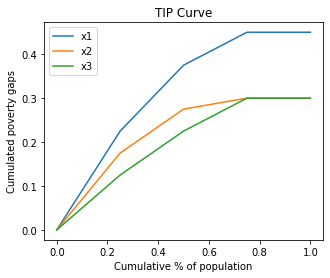
Exercise: Contribution of each subgroup to aggregate poverty¶
Another convenient feature of the FGT class of poverty measures is that they can be disaggregated for population subgroups and the contribution of each subgroup to aggregate poverty can be calculated. For instance:
[36]:
x = [23, 10, 12, 21, 4, 8, 19, 15, 5, 7]
y = [10,10,20,10,10,20,20,20,10,10]
region = ['urban','urban','rural','urban','urban','rural','rural','rural','urban','urban']
dfa = pd.DataFrame({'x':x,'region':region})
ada1 = ApodeData(dfa,income_column='x')
ada1
[36]:
| x | region | |
|---|---|---|
| 0 | 23 | urban |
| 1 | 10 | urban |
| 2 | 12 | rural |
| 3 | 21 | urban |
| 4 | 4 | urban |
| 5 | 8 | rural |
| 6 | 19 | rural |
| 7 | 15 | rural |
| 8 | 5 | urban |
| 9 | 7 | urban |
[39]:
# group calculation according to variable "y"
pline = 11
pg = poverty_groupby(ada1,'headcount',group_column='region', pline=pline)
pg
[39]:
| x_measure | x_weight | |
|---|---|---|
| rural | 0.250000 | 4 |
| urban | 0.666667 | 6 |
[40]:
# simple calculation
ps = ada1.poverty('headcount',pline=pline)
ps
[40]:
0.5
[41]:
# If the indicator is decomposable, the same result is attained:
pg_p = sum(pg['x_measure']*pg['x_weight']/sum(pg['x_weight']))
pg_p
[41]:
0.5
Inequality¶
The following inequality measures are implemented:
gini: Gini Indexentropy: Generalized Entropy Indexatkinson: Atkinson Indexrrange: Relative Rangerad: Relative average deviationcv: Coefficient of variationsdlog: Standard deviation of logmerhan: Merhan indexpiesch: Piesch Indexbonferroni: Bonferroni Indiceskolm: Kolm Index
Also the Lorenz and Pen curves, which allows for a graphic comparison of inequality among different distributions.
Numerical measures¶
[18]:
# Evaluate an inequality method
q = ad2.inequality('gini')
q
[18]:
0.3652184907296814
The summary function shows the result of various methods:
[19]:
df_ineq = inequality_summary(ad2)
df_ineq
[19]:
| method | measure | |
|---|---|---|
| 0 | rrange | 4.194905 |
| 1 | rad | 0.264575 |
| 2 | cv | 0.664905 |
| 3 | sdlog | 0.916263 |
| 4 | gini | 0.365218 |
| 5 | merhan | 0.512500 |
| 6 | piesch | 0.288587 |
| 7 | bonferroni | 0.510418 |
| 8 | kolm(0.5) | 36.566749 |
| 9 | ratio(0.05) | 0.032061 |
| 10 | ratio(0.2) | 0.118795 |
| 11 | entropy(0) | 0.281897 |
| 12 | entropy(1) | 0.217586 |
| 13 | entropy(2) | 0.221049 |
| 14 | atkinson(0.5) | 0.114579 |
| 15 | atkinson(1.0) | 0.245649 |
| 16 | atkinson(2.0) | 0.631276 |
Graph measures¶
The relative, generalized and absolute Lorenz Curves are implemented. Alse de Pen Parade curve.
[20]:
# Lorenz Curves
ad2.plot.lorenz();

[21]:
# Generalized Lorenz Curve
ad2.plot.lorenz(alpha='g');
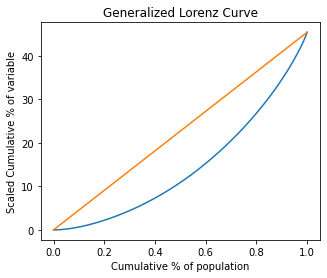
[22]:
# Absolute Lorenz Curve
ad2.plot.lorenz(alpha='a');

[23]:
# Pen's Parade
ad2.plot.pen(pline=60);
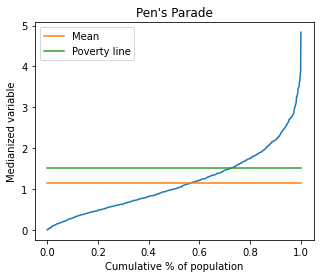
Exercise: Redistributive Effect of Fiscal Policy¶
Income pre and post fiscal policy:
[24]:
# Income pre fiscal policy:
y_pre = np.array([20, 30, 40, 60, 100])
# Fiscal policy
tax = 0.2*np.maximum(y_pre-35,0) # tax formula
revenue = np.sum(tax) # total revenue
transfers = revenue/len(y_pre) # per capita transfers
# Income post fiscal policy:
y_post = y_pre - tax + transfers
[25]:
# ApodeData
df_pre = pd.DataFrame({'y1':y_pre})
ad_pre = ApodeData(df_pre,income_column='y1')
df_post = pd.DataFrame({'y2':y_post})
ad_post = ApodeData(df_post,income_column='y2')
ad_post
[25]:
| y2 | |
|---|---|
| 0 | 23.8 |
| 1 | 33.8 |
| 2 | 42.8 |
| 3 | 58.8 |
| 4 | 90.8 |
[26]:
# Gini
ad_pre.inequality.gini(), ad_post.inequality.gini() # decrease inequality
[26]:
(0.30399999999999994, 0.25440000000000024)
[27]:
# Lorenz Curves
ax = ad_pre.plot.lorenz()
ad_post.plot.lorenz(ax=ax);
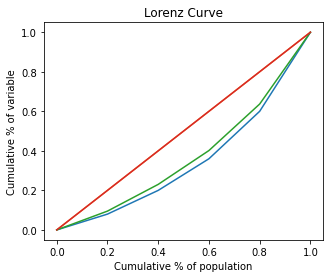
Welfare¶
The following welfare measures are implemented:
utilitarian: Utilitarian utility functionrawlsian: Rawlsian utility functionisoelastic: Isoelastic utility functionsen: Sen utility functiontheill: Theill utility functiontheilt: Theilt utility function
[28]:
# Evaluate a welfare method
w = ad2.welfare('sen')
w
[28]:
28.824397753868958
The summary function shows the result of various methods:
[29]:
df_wlf = welfare_summary(ad2)
df_wlf
[29]:
| method | measure | |
|---|---|---|
| 0 | utilitarian | 45.408376 |
| 1 | rawlsian | 0.112876 |
| 2 | sen | 28.824398 |
| 3 | theill | 34.253866 |
| 4 | theilt | 36.529160 |
| 5 | isoelastic(0) | 45.408376 |
| 6 | isoelastic(1) | 3.533799 |
| 7 | isoelastic(2) | -0.059726 |
| 8 | isoelastic(inf) | 0.112876 |
Polarization¶
The following welfare measures are implemented:
ray: Esteban and Ray indexwolfson: Wolfson index
[30]:
# Evaluate a polarization method
p = ad2.polarization('ray')
p
[30]:
0.03316795744715791
The summary function shows the result of various methods:
[31]:
df_pz = polarization_summary(ad2)
df_pz
[31]:
| method | measure | |
|---|---|---|
| 0 | ray | 0.033168 |
| 1 | wolfson | 0.357081 |
Concentration¶
The following concentration measures are implemented:
herfindahl: Herfindahl-Hirschman Indexrosenbluth: Rosenbluth Indexconcentration_ratio: Concentration Ratio Index
[32]:
# Evaluate a concentration method
c = ad2.concentration('herfindahl')
c
[32]:
0.00044254144331556705
The summary function shows the result of various methods:
[33]:
df_conc = concentration_summary(ad2)
df_conc
[33]:
| method | measure | |
|---|---|---|
| 0 | herfindahl | 0.000443 |
| 1 | herfindahl(norm) | 0.000443 |
| 2 | rosenbluth | 0.001575 |
| 3 | concentration_ratio(1) | 0.004197 |
| 4 | concentration_ratio(3) | 0.010900 |
References¶
Schröder, C. (2011). Cowell, F.: Measuring Inequality. London School of Economics Perspectives in Economic Analysis.
Adler, M. D., & Fleurbaey, M. (Eds.). (2016). The Oxford handbook of well-being and public policy. Oxford University Press.
Haughton, J., & Khandker, S. R. (2009). Handbook on poverty+ inequality. World Bank Publications.
Gasparini, L., Cicowiez, M., & Sosa Escudero, W. (2012). Pobreza y desigualdad en América Latina. Temas Grupo Editorial.
Araar, A., & Duclos, J. Y. (2007). DASP: Distributive analysis stata package. PEP, World Bank, UNDP and Université Laval.
Apendix¶
[15]:
# Evaluating a list of poverty methods
def poverty_summary(ad, pline=None, factor=1.0, q=None):
import apode
#y = ad[ad.income_column].values # ver falla
y = ad.x.values
pline = apode.poverty._get_pline(y, pline, factor, q)
pov_list = [["headcount", None],
["gap", None],
["severity",None],
["fgt",1.5],
["sen",None],
["sst",None],
["watts",None],
["cuh",0],
["cuh",0.5],
["takayama",None],
["kakwani",None],
["thon",None],
["bd",1.0],
["bd",2.0],
["hagenaars",None],
["chakravarty",0.5]]
p = []
pl = []
for elem in pov_list:
if elem[1]==None:
p.append(ad.poverty(elem[0],pline=pline))
pl.append(elem[0])
else:
p.append(ad.poverty(elem[0],pline=pline,alpha=elem[1]))
pl.append(elem[0] + '(' + str(elem[1]) +')')
df_p = pd.concat([pd.DataFrame(pl),pd.DataFrame(p)],axis=1)
df_p.columns = ['method','measure']
return df_p
# Evaluate a list of inequality methods
def inequality_summary(ad):
ineq_list = [["rrange", None],
["rad", None],
["cv",None],
["sdlog",None],
["gini",None],
["merhan",None],
["piesch",None],
["bonferroni",None],
["kolm",0.5],
["ratio",0.05],
["ratio",0.2],
["entropy",0],
["entropy",1],
["entropy",2],
["atkinson",0.5],
["atkinson",1.0],
["atkinson",2.0]]
p = []
pl = []
for elem in ineq_list:
if elem[1]==None:
p.append(ad.inequality(elem[0]))
pl.append(elem[0])
else:
p.append(ad.inequality(elem[0],alpha=elem[1]))
pl.append(elem[0] + '(' + str(elem[1]) +')')
df_ineq = pd.concat([pd.DataFrame(pl),pd.DataFrame(p)],axis=1)
df_ineq.columns = ['method','measure']
return df_ineq
# Evaluate a list of welfare methods
def welfare_summary(ad):
wlf_list = [["utilitarian", None],
["rawlsian", None],
["sen",None],
["theill",None],
["theilt",None],
["isoelastic",0],
["isoelastic",1],
["isoelastic",2],
["isoelastic",np.Inf]]
p = []
pl = []
for elem in wlf_list:
if elem[1]==None:
p.append(ad.welfare(elem[0]))
pl.append(elem[0])
else:
p.append(ad.welfare(elem[0],alpha=elem[1]))
pl.append(elem[0] + '(' + str(elem[1]) +')')
df_wlf = pd.concat([pd.DataFrame(pl),pd.DataFrame(p)],axis=1)
df_wlf.columns = ['method','measure']
return df_wlf
# Evaluate a list of polarization methods
def polarization_summary(ad):
pol_list = [["ray", None],
["wolfson", None]]
p = []
pl = []
for elem in pol_list:
if elem[1]==None:
p.append(ad2.polarization(elem[0]))
pl.append(elem[0])
else:
p.append(ad2.polarization(elem[0],alpha=elem[1]))
pl.append(elem[0] + '(' + str(elem[1]) +')')
df_pz = pd.concat([pd.DataFrame(pl),pd.DataFrame(p)],axis=1)
df_pz.columns = ['method','measure']
return df_pz
# Evaluate a list of concentration methods
def concentration_summary(ad):
conc_list = [["herfindahl", None],
["herfindahl", True],
["rosenbluth",None],
["concentration_ratio",1],
["concentration_ratio",3]]
p = []
pl = []
for elem in conc_list:
if elem[1]==None:
p.append(ad2.concentration(elem[0]))
pl.append(elem[0])
else:
if elem[0]=="herfindahl":
p.append(ad2.concentration(elem[0],normalized=elem[1])) # check keyword
pl.append(elem[0] + '(norm)')
elif elem[0]=="concentration_ratio":
p.append(ad2.concentration(elem[0],k=elem[1])) # check keyword
pl.append(elem[0] + '(' + str(elem[1]) +')')
else:
p.append(ad2.concentration(elem[0],alpha=elem[1]))
pl.append(elem[0] + '(' + str(elem[1]) +')')
df_conc = pd.concat([pd.DataFrame(pl),pd.DataFrame(p)],axis=1)
df_conc.columns = ['method','measure']
return df_conc
[16]:
# receives a dataframe and applies a measure according to the column "varg"
def poverty_groupby(ad,method,group_column,**kwargs):
return measure_groupby(ad,method,group_column,measure='poverty',**kwargs)
def measure_groupby(ad,method,group_column,measure,**kwargs):
a = []; b = []; c = []
for name, group in ad.groupby(group_column):
adi = ApodeData(group,income_column=ad.income_column)
if measure=='poverty':
p = adi.poverty(method,**kwargs)
elif measure=='inequality':
p = adi.inequality(method,**kwargs)
elif measure=='concentration':
p = adi.concentration(method,**kwargs)
elif measure=='polarization':
p = adi.polarization(method,**kwargs)
elif measure=='welfare':
p = adi.welfare(method,**kwargs)
a.append(name)
b.append(p)
c.append(group.shape[0])
xname = ad.income_column + "_measure"
wname = ad.income_column + "_weight"
return pd.DataFrame({xname: b, wname: c}, index=pd.Index(a))
